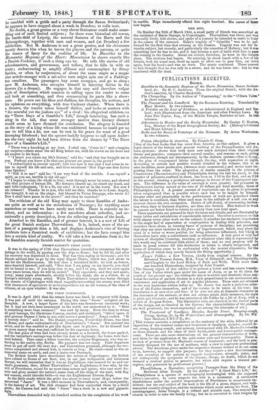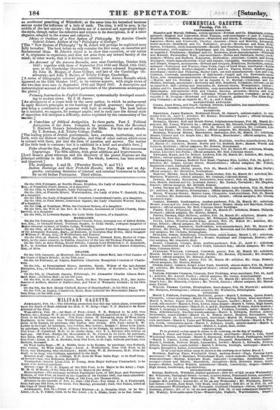PUBLICATIONS RECEIVED.
BOOKS.
Rambles in the Romantic Regions of the Hartz Mountains, Saxon Swifter- land, 4-e. By H. C. Andersen. From the original Danish, with the An- thor's sanction, by Charles Beckwith. The Changeling. By the Author of " Canvassing," in the " O'Hara Tales." In three volumes.
The Peasant and his Landlord. By the Baroness Bawling. Translated by Mary Hewitt. In two volumes.
A Treatise on the Law of Evidence, as Administered in England and Ire- land; with Illustrations from the American and other Foreign Laws. By John Pitt Taylor, Esq., of the Middle Temple, Barrister-at-law. In tWO volumes.
Adventures in Mexico and the Rocky Mountains. By George F. Ruston, Eaq., Member of the Royal Geographical Society, &c. (Murray's Colonial an Home Library.) Rollo and his Race; or Footsteps of the Normans. By Acton Warburton. In two volumes.
Prison Discipline in America. By Francis C. Gray. [One of the best books that has come from America on this subject. It gives rapid sketch of the history and present working of the Pennsylvanian and Au- burn systems; shows that both have now much deviated from their original theory and practice; compares their several results; and reasons on each, giving the preference, though not intemperately, to the Auburn system—that is to say, to the plan of congregated labour through the day, with separation at night. According to certain and positive results detailed in the volume, this is at once healthier, more productive, (whence more economical,) and seems more im- proving than the other. The proportion of deaths annually in the prisons of Charlestown (Massachusetts) and Philadelphia during the last ten years, to the number of prisoners confined in them, has been as 1.19 in the first, and as 2.18 in the second; showing a prodigious advantage in favour of the Congregated sys- tem. The difference in the value of earnings is even greater; the prisoners in Charlestown having earned at the rate of 10 dollars per head monthly, those of Philadelphia only 4. A greater amount of instruction can be given to prisoners when congregated than is possible where each has to be taught by himselE, Greater order and punctuality in the performance of work are generated where the labour is combined, than when each man in the solitude of a cell can at any moment choose his own occupation. Habits of self-denial, of overcoming tion when duty or business requires, are thus also formed. Men trained to work in concert are better fitted to return to society than men kept apart. These arguments are pursued in their divisions and details, and are illustrated by many tables and calculations of considerable interest. One error is common to this with almost every other work on the subject: it attaches too exclusive importance to the single fact of separation or congregation in dealing with prisoners, and considers them alone, as forming bases of systems of discipline; not perceiving that they are mere varieties in the form of imprisonment, which may place the mind in a better or worse position for being otherwise influenced, but which in themselves have only a subordinate rank as influences. A very good or very bad system of discipline (training, teaching, or whatever other idea is represeuted by this word) may be combined with either of them; and no real progress will be made in penal science till this distinction in terms is clearly recognized, and forms of detention cease to be confounded with the mental stimulants, for the application of which they merely furnish the fitting opportunity.] ..Esop's Fables: a New Version, chiefly from original sources. By the Reverend Thomas James, ALA., Vicar of Sibbertoft and Theddiogworth, and Chaplain to the Lord Bishop of Bath and Wells. With more than one hundred Illustrations, designed by John Tenniel. [The literary object of this edition is to present a better and lees coarse transla- tion of the Fables which pass under the name of /Esop, so as to fit them for youth of the present age: the bibliopolic aim is to clothe and illustrate those uni- versal favourites of ancient wisdom in a style proportioned to our mechanical ad- vancement and application of art to popular pleasure. These ends are attained in the very handsome edition before us. Mr. James has made a judicious Belo• tion of the Fables themselves, and of the version to be taken as his text: his translation is at once close and free; if he does not aim at dramatic character in the discourse of the animals, or does not always attain Attic terseness, his style is plain and idiomatic; and he has introduced the Fables by a life of .ffisop, with a review of .Esopian fiction. The illustrative tuts are classical in the formal parts of the design, not so classical in the figures; the characteristics of the animals are well preserved; the wood-engravings are among the triumphs of art.] The Treatment of Smallpox, Measles, Scarlet Fever, Hooping-cough, Croup, Quinsy, 4-c. by the Water-Cure and Homeopathy. By Dr. Wit Liam Macleod, F.R.C.P.E., &c. [This volume contains a compilation on the anatomy of the skin, followed by an exposition of the received causes and treatment of smallpox, measles, scarlet fe- ver, croup, hooping-cough, and quinsey, interspersed with Dr. Macleod'a remarks on those dieeaeee and his ideas of their hydropathic and homoeopathic manage- ment. There are also seine observations on the general characteristics of fever,
and hints for the application of the cold-water cure and hornoiepathy. There is
no lack of promises from Dr. Macleod's course of treatment; and the book ispro- fessedly designed for the use of mothers, with a view to supersede professional advice. The directions given under the respective diseases treated of do not seem to us, however, to support this purpose; for they require a nice discrimination of the condition of the patient as regards temperature, strength, pulse, and not mifrequently the symptoms of the disease; things, no doubt, which do not demand a medical genius to perceive, but which still require a trained per- ception, only possessed by professional persons.] Thankfulness, a Narrative; comprising Passages from the Diary of the Reverend Allan Temple. By the Author of " A Good Man's Life," &c. [Thankfulness is a species of autobiography intermingled with the supposed editor's narrative. In some respects the title is a misnomer. A submissive thankfulness under the painful dispensations of Providence is occasionally ex- hibited; but the real subject of the book is the life of a pious, elegant, and well- connected country clergyman, and the incidents which occur among his flock. The autobiographer, Allan Temple, is a refined and amiable man, who entered the church in order to take the family living; but he is converted to vital religion by
an accidental preaching of Whitefield; at the same time his betrothed becomes serious under the influence of a lady of rank. The time, it will be seen, is the middle of the last century: the incidents are of a natural and appropriate kind : the style, though rather too reflective and minute in its descriptions, is of a sober elegance, adapted to the scenes and subjects.] Ideas; or Outlines of a New System of Philosophy. By Antoine Claude Gabriel Jobert, Author of the " Philosophy of Geology." [The " New System of Philosophy" by M. Jobert will perhaps be explained more fully hereafter. The book before as only contains the first essay, on causation and fundamental ideas. M. Jobert's object is to show that causation, or our notion of it, originates in experience, and does not arise from any inward faculty of the mind; in other words, that it is derived, not innate.]
An Account of the Aurora Borealis, seen near Cambridge, October 24th 1847; together with those of September 21st 1846 and March 19th 1847, seen at the Cambridge Observatory. With twelve coloured Engravings. By John H. Morgan, of Jesus College, and late of the Cambridge Ob- servatory; and John T. Barber, of Trinity College, Cambridge.
[A series of lithographic coloured plates exhibiting the Aurora Borealis which appeared on the 24th October 1847, in its various aspects, with single views of the two that were seen in September 1846 and March 1847. A descriptive and meteorological account of the observed particulars of the pliamomena accompanies the plates.] Prinsary Instruction in English Grammar, systematically developed accord- ing to modern views. By J. H. James.
[An abridgment of a larger book by the same author, in which he endeavoured to apply Becker's principles to the teaching of English grammar; those princi- ples hemg a combination of grammar with logic or ontology. The book before Its is intended, we suppose, for younger pupils; and in such case the formal style of exposition will interpose a difficulty, unless explained by the commentary of the teacher.]
A Catechism of Biblical Antiquities. In three parts. Part L Political Antiquities of the Jews. Compiled, by permission, from the Reverend T. Hartwell Horne's Introduction to the Bible. For the use of schools. By T. Bowman, A.B. Trinity College, Dublin.
CThe leading points of Jewish governments, laws, customs, institutions, and so forth, with the Hebrew military discipline, and that of other nations which came in contact with them, put into the form of question and answer. The matter of the little book is common; but it is exhibited in a brief and available form.] Tales about the Sun, Moon; and Stars. By Peter Parley. With viumerona Engravings. The fifth edition, with great additions and improvements. [Lord Rosse's great telescope and the discovery of the planet Neptune are the principal additions to this fifth edition. The whole, however, has been revised and improved.)
The Antiquary. L and II. (Waverley Novels, V. and VI.)
Indian Railways and their Probable Results; with Maps and an Ap- pendix, containing Statistics of internal and external Commerce in India. By an old Indian Postmaster. Third edition.



























 Previous page
Previous page